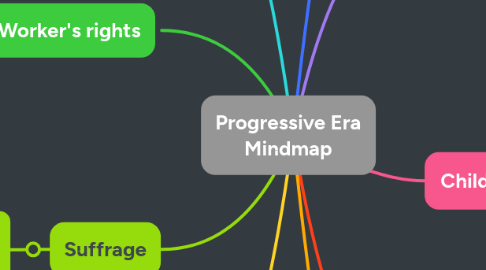
1. Health & Safety
1.1. Problems: People were unsure of what was going into their food and with the publishing of the book The Jungle people continued to become even more worried. The Jungle also revealed the unsafe working conditions and unsanitary conditions of factory workers. At the time there was also a lack of healthcare that caught peoples attention.
1.1.1. Reformers: Upton Sinclair was the author of The Jungle which revealed the unsanitary and poor working conditions of factory workers. Alice Hamilton was a doctor that helped lots of factory workers and she noticed some of the sicknesses were from things in the factory. Lillian Wald established a visiting nurse program for people who were too sick to visit a doctor.
1.1.1.1. Solutions: After the release of The Jungle president Theodore Roosevelt passed the pure food and drug act which banned the sale of impure medicines and foods. Alice Hamilton taught factory owners to keep their factories clean and safe.
2. Worker's rights
2.1. Problems: With a large influx in immigration more and more people became factory workers. Factory workers were however paid very low wages while having to work very long days. With low wages most people couldn't afford to care for their families so their children would have to work in factories as well.
2.1.1. Reformers: Labor Unions would be created to help fight for change using strikes. Samuel Gompers was a popular union leader and he helped create the American Federation of Labor.
2.1.1.1. Solutions: The creation of labor unions and strikes led to change of payment rates and work days.
3. Suffrage
3.1. Problems: Women had been fighting for the right to vote for decades.
3.1.1. Reformers: In 1890 two women suffrage groups came together to create the National American Women Suffrage Association which fought for women's rights. Elizabeth Cady Stanton was the first president for the NAWSA. In 1892 Susan B. Anthony became the president of the NAWSA.
3.1.1.1. Solutions: With the NAWSA constantly fighting for better women rights congress created the 19th amendment which gave women full womens rights.
4. Prohibition
4.1. Problems: Multiple groups were pushing for the banning of alcohol saying it led to multiple bad things in American society.
4.1.1. Reformers: The Temperance Movement was a group of people that called for the ban of selling alcohol. Many people that supported prohibition like Mary Hunt believed it would lead to healthier decisions and therefore a healthier society. Carrie Nation was an advocate for prohibition was very extreme in her methods even taking a hatchet to some saloons
4.1.1.1. Solution: The 18th amendment banned the manufacturing and sale of alcohol and forced saloons to close their doors.
4.1.1.1.1. Unintended Consequences: People disagreed with prohibition and therefore created secret bars called speakeasies which sold liquor. Some people referred to as bootleggers would transport and sell alcohol illegally. Prohibition also led to the growth of organized crime.
5. Poverty
5.1. Problems: With the increase in immigration some areas were over crowded so people moved into rented apartments and crowded tenements. Tenements were often very unsafe, poorly designed, and lacked running water, electricity, and sanitation.
5.1.1. Reformers: Jacob A. Riis exposed the living conditions of the poor and inspired the upper class. Jane Addams helped improve living conditions by establishing the Hull house.
5.1.1.1. Solutions: Settlement houses were set up and provided opportunities for education, child care, and work
6. Corruption
6.1. Problems: Due to the massive success of large businesses people and governments were becoming increasingly corrupt to the point where officials would bribe others to get voted in. The new corruption led to the creation of political machines like Tammany hall. Political machines were businesses set up to influence votes and they were controlled by the local government.
6.1.1. Reformers: Robert M. La Follette established a direct primary in Wisconsin.
6.1.1.1. Solution: Give voters the ability to vote to remove government officials, allow them to propose laws, and let voters vote on proposed laws.
7. Child Labor
7.1. Reformers: Lewis Hine was a photographer that showed the lives of children working in factories. His pictures were published in to multiple books and magazines. With the outreach of his photos he helped end child labor. The National Child Labor Committee was also dedicated to ending child labor. Members of the NCLC worked to expose the working conditions of children
7.1.1. Solutions: The NCLC helped create the Compulsory Education laws which required children to have an education and kept young children from working dangerous jobs.
8. Racism
8.1. Problems: Poll taxes were created along with tests required to be taken before being able to vote. The Jim Crow laws were created which enforced segregation
8.1.1. Reformers: Ida B. Wells was an African American journalist who was fighting against black lynching in the south. W. E. B. Du Bois helped create the National Association for the Advancement of Colored People which fought against discrimination. N.A.A.C.P. continues to fight for their cause today. Booker T. Washington created the Tuskegee Institute which taught African Americans trades and helped them gain economic strength.
8.1.1.1. Solutions: The N.A.A.C.P. and the Tuskegee Institute were set up to help the future of African Americans and help end racism.
9. Conservation
9.1. Problems: At the time more and more natural resources were disappearing rapidly.
9.1.1. Reformers: President Theodore Roosevelt helped double the amount of National Parks along with establishing the first wildlife refuge.
9.1.1.1. Solutions: A solution used by Theodore Roosevelt was establishing more national parks and creating laws making businesses obey the laws of natural resources.
